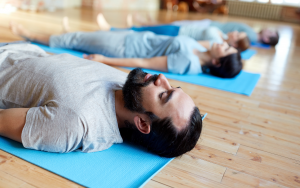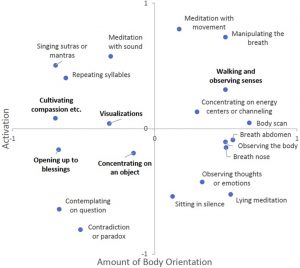Breathing-Focused Yoga Practices Produce Greater Benefits for College Students than Meditative-Focused Practices
By John M. de Castro, Ph.D.
“Want to manage your anger so you don’t feel you’re always on the verge of blowing up? Want to feel less stressed and juggle all the things going on in your life? Need to focus better in class or while you do your homework? Yoga poses can help. But meditation and breathing really round out those benefits.” – Mary L. Gavin
Yoga training has been shown to improve health and well-being. It has also been found to be effective for a large array of medical and psychiatric conditions, either stand-alone or in combination with more traditional therapies. There are a wide variety of different yoga training techniques. Many varieties employ breath-focused practices while many others employ meditative-focused practices. Although the benefits of yoga practices in general are well studied there is little scientific research comparing breathing-focused versus meditative-focused yoga.
In today’s Research News article “Comparing the Psychological Effects of Meditation- and Breathing-Focused Yoga Practice in Undergraduate Students.” (See summary below or view the full text of the study at: https://www.frontiersin.org/articles/10.3389/fpsyg.2020.560152/full?utm_source=F-AAE&utm_medium=EMLF&utm_campaign=MRK_1490157_69_Psycho_20201124_arts_A ) Qi and colleagues recruited college students with no yoga experience and randomly assigned them to a once a week for 80 minutes 12-week program of either breath-focused yoga or meditation-focused yoga. During each Hatha yoga class the students received either 10 minutes of meditation practice or breathing practice. They were measured before and after the program for work intention, mindfulness, and perceived stress.
They found that both before and after yoga training the higher the participants’ levels of mindfulness the lower their levels of perceived stress. They further found that in comparison to baseline and the other yoga group, the breath-focused yoga group had significantly higher levels of perceived stress and mindfulness while the meditation-focused yoga group had significantly lower work intention.
These results are interesting and document the previously reported linkage between mindfulness and lower stress levels. But they go further in demonstrating that breath-focus is an important component of yoga practice for the improvement of mindfulness and the lowering of perceived stress. This suggests that breathing practice should be emphasized in yoga instruction. These results also suggest that yoga practice may be beneficial for college students who are routinely found to have high stress levels, reducing their stress and thereby allowing them to perform their best in their studies.
So, breathing-focused yoga practices produce greater benefits for college students than meditative-focused practices.
“Mindful yoga (or the integration of yoga and mindfulness meditation techniques) provides a healthy and safe environment for individuals to practice “being with” uncomfortable emotional and physical experiences, and to eventually reunite with and fully inhabit their bodies.” – Melissa Mercedes
CMCS – Center for Mindfulness and Contemplative Studies
This and other Contemplative Studies posts are also available on Google+ https://plus.google.com/106784388191201299496/posts and on Twitter @MindfulResearch
Study Summary
Qi X, Tong J, Chen S, He Z and Zhu X (2020) Comparing the Psychological Effects of Meditation- and Breathing-Focused Yoga Practice in Undergraduate Students. Front. Psychol. 11:560152. doi: 10.3389/fpsyg.2020.560152
ABSTRACT
Objectives: The present study aimed to compare the psychological effects of meditation- and breathing-focused yoga practice in undergraduate students.
Methods: A 12-weeks yoga intervention was conducted among a group of undergraduate students enrolled in four yoga classes at an academically prestigious university in Beijing, China. Four classes were randomized to meditation-focused yoga or breathing-focused yoga. A total of 86 participants finished surveys before and after the 12-weeks intervention, measuring work intention, mindfulness, and perceived stress. The repeated-measure multivariate analysis of covariance (MANCOVA) followed by univariate analyses were conducted to examine the differences in work intention, mindfulness, and stress between the two yoga intervention groups over the semester, after controlling for age and gender.
Results: The repeated-measure MANCOVA revealed significant group differences with a median effect size [Wilks’ lambda, Λ = 0.90, F(3, 80) = 3.10, p = 0.031, η2 = 0.104]. Subsequent univariate analyses showed that students in the breathing-focused yoga group had significant higher work intentions [F(1, 82) = 5.22; p = 0.025; η2p = 0.060] and mindfulness [F(1, 82) = 6.33; p = 0.014; η2p = 0.072] but marginally lower stress [F(1, 82) = 4.20; p = 0.044; η2p = 0.049] than students in the meditation-focused yoga group.
Conclusion: Yoga practice with a focus on breathing is more effective than that with a focus on meditation for undergraduates to retain energy for work, keep attention and awareness, and reduce stress.






